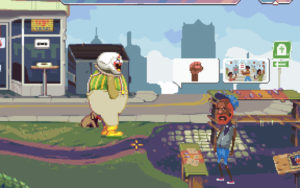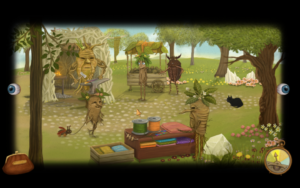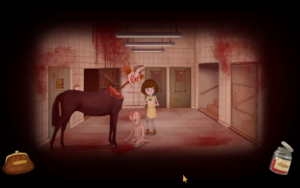Dropsy: Missions and Exploration
Not much progress in Dropsy today. I managed to befriend a couple more people, but I’m very stuck on my current mission.
Yeah, there are missions. I hadn’t mentioned that. They’re given to you by a green-haired friend/coworker of the clown who sleeps in the same circus tent. The first mission, which I barely understood, was to deliver a gift to a grave. The second is to recover a tire that the coworker had taken off his motorcycle, but which was stolen by a bird. That’s where I’m stuck. The bird is easy to find, but it’s fierce, and drives off any clowns that approach its nest. I’m pretty sure the solution involves enlisting the aid of a guy in a chicken costume in the town, but he doesn’t like the clown and I have no idea how to change that.
Now, the reason that it’s easy to find the bird is that your current mission is marked with an icon on the world map. Another icon indicates your current location. Other locations you’ve visited are marked with simple dots, which really makes it look like you should be able to click on them for fast travel, but that doesn’t seem to be the case. Unexplored regions are shrouded by clouds. At the point I’m at, this just means places beyond locked gates or similar impasses, because obviously the first thing you do when you’re stuck is conduct a thorough exploration.
And even without solving any puzzles, it’s a fairly large and explorable environment, with a lot to see and do. Checking it all out is definitely what the game wants you to do. But to a certain extent, it feels like this clown just wandered off down a random road while his friend is waiting for that tire. It’s exactly the sort of thing you’d do in any adventure game, but it’s also in character.
 Comments(0)
Comments(0)


